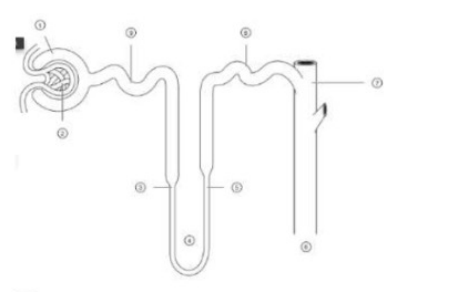Identify the correctly matched structures and numbers. (Select all that apply)

Glomerulus - 6
PCT-9
Distal convoluted tubule - 8
Nephron loop - 3, 4 and 5
DCT-9
Glomerular capsule - 1
Collecting duct – 1
Correct Answer : D,F
A. Glomerulus – 6: The glomerulus is the capillary tuft labeled 2, not 6.
B. PCT – 9: The proximal convoluted tubule is labeled 7 (first coiled segment after the capsule); there is no 9 shown.
C. Distal convoluted tubule – 8: The DCT is labeled 6 (coiled segment after the ascending limb). 8 points to the collecting system.
D. Nephron loop – 3, 4 and 5: 3 = descending limb, 4 = hairpin turn, 5 = ascending limb.
E. DCT – 9: DCT is 6; no 9 indicated.
F. Glomerular capsule – 1: The capsule (Bowman’s capsule) encasing the glomerulus is labeled 1.
G. Collecting duct – 1: The collecting duct is the long vertical duct on the right (labeled 7/8), not 1.
Nursing Test Bank
Naxlex Comprehensive Predictor Exams
Related Questions
Correct Answer is B
Explanation
A. Muscularis externa, submucosa, mucosa, serosa: This is out of order -muscularis externa is deeper than serosa but more superficial than the mucosa, so this ordering is incorrect.
B. Mucosa, submucosa, muscularis externa, serosa: The mucosa (deepest layer lining the lumen) → submucosa → muscularis externa → serosa (outermost)is the correct sequence from deep to superficial .
C. Serosa, muscularis externa, submucosa, mucosa: This lists the layers from superficial to deep (reverse of what the question asked), so incorrect for deep to superficial.
D. Submucosa, mucosa, muscularis externa, serosa: This places submucosa deeper than mucosa (wrong); incorrect order.
Correct Answer is ["C","D","E"]
Explanation
A. Converted to carbon monoxide: CO (carbon monoxide) is a different gas and is not a product or transport form of CO₂.
B. Bind to myoglobin: Myoglobin primarily binds O₂ within muscle cells; CO₂ transport by myoglobin is not a main mechanism.
C. Binds to hemoglobin: CO₂ can bind to hemoglobin (forming carbaminohemoglobin) as one transport form.
D. Converted to bicarbonate ions: Most CO₂ is converted to bicarbonate (HCO₃⁻) in red blood cells and transported in plasma.
E. Dissolved in plasma: A small proportion of CO₂ is carried dissolved directly in plasma.
Whether you are a student looking to ace your exams or a practicing nurse seeking to enhance your expertise , our nursing education contents will empower you with the confidence and competence to make a difference in the lives of patients and become a respected leader in the healthcare field.
Visit Naxlex, invest in your future and unlock endless possibilities with our unparalleled nursing education contents today
Report Wrong Answer on the Current Question
Do you disagree with the answer? If yes, what is your expected answer? Explain.
Kindly be descriptive with the issue you are facing.
